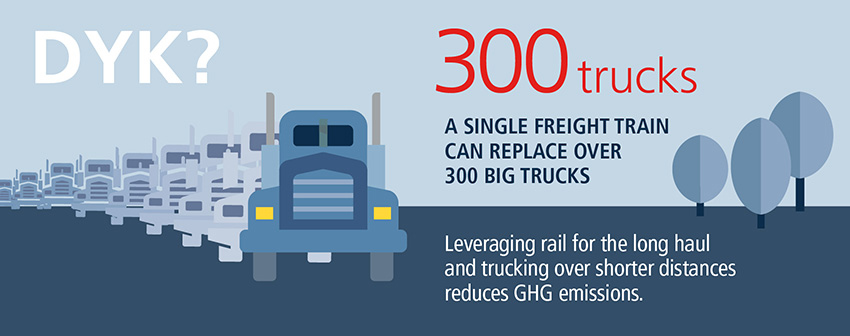
Emissions and Energy Efficiency
We believe an integral part of our success depends on our ability to mitigate the impact of, and adapt our business to, changing climatic conditions. Our carbon footprint covers our rail locomotive fleet, non-rail vehicle and vessel fleets, and buildings and yards. With 85% of our GHG emissions generated from rail operations, we believe the single best way we can positively impact the environment is by continuously improving our locomotive operating efficiency and reducing our carbon footprint.
 Download the latest CDP report
Download the latest CDP report
 Download the GHG Emissions Assurance Statement
Download the GHG Emissions Assurance Statement
Our Performance
GHG Emissions
Intensity Reduction

43%
reduction of locomotive carbon
emissions intensity since 1993
One of the Industry Leaders
in Rail Fuel Efficiency

15%
less fuel per gross ton
mile than industry average
Non-Rail Carbon
Reduction

33%
carbon reduction from electricity
at key yards since 2011
Reducing our Rail Carbon Footprint
Over the years, the pursuit of efficiency has been the hallmark of our success. With Precision Railroading, fuel efficient locomotives, leading edge technology and numerous other programs, we achieved a fuel and carbon efficiency improvement of 40% over the past 25 years.
- Using fewer rail cars and locomotives to ship more freight
- Promoting fuel conservation practices
- Driving efficiency across the supply chain
- Deploying leading edge technologies
- Operating through efficient routing protocols
- Optimizing yard performance
- Upgrading our locomotive fleet
Reducing Our Non-Rail Carbon Footprint
Building on our industry leading rail fuel efficiency programs, we continue to extend the same efficiency mindset to our non-rail fleet including our intermodal equipment and trucking fleet, On Company Service (OCS) vehicles and our Great Lakes shipping vessels. Together, they represent 9% of our total carbon footprint.
Improving Efficiency at Our Building and Yards
Our buildings and yards account for approximately 7% of our carbon emissions, comprising electricity, natural gas and miscellaneous fuel consumption. We are committed to improving the use of energy in our existing buildings and yards, while integrating more sustainable designs into new buildings.